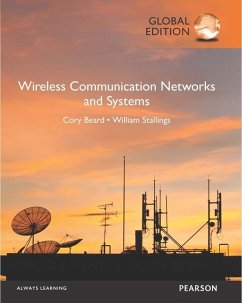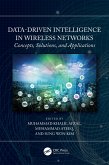For courses in wireless communication networks and systems
A Comprehensive Overview of Wireless Communications
Wireless Communication Networks and Systems covers all types of wireless communications, from satellite and cellular to local and personal area networks. Organized into four easily comprehensible, reader-friendly parts, it presents a clear and comprehensive overview of the field of wireless communications. For those who are new to the topic, the book explains basic principles and fundamental topics concerning the technology and architecture of the field. Numerous figures and tables help clarify discussions, and each chapter includes a list of keywords, review questions, homework problems, and suggestions for further reading. The book includes an extensive online glossary, a list of frequently used acronyms, and a reference list. A diverse set of projects and other student exercises enables instructors to use the book as a component in a varied learning experience, tailoring courses to meet their specific needs.
Features + Benefits
Convenient organization into four parts: technical background, wireless communication technology, wireless local and personal area networks, and mobile wireless networks and applications.
Animations provide a powerful tool for understanding the complex mechanisms discussed in this book, including forward error correction, signal encoding, and protocols. Over 150 Web-based animations illustrate data communications and protocol concepts.
Supporting material for students available online at two websites. The companion website, www.corybeardwireless.com, includes:
Social Networking Tools: Students can share questions and insights and develop relationships. As new social networking sites are developed, links and information will be made available.
Useful Websites: Links to other relevant sites which provide extensive help in studying these topics.
Errata sheet: An errata list for this book will be maintained and updated as needed.
Documents: includes a number of documents that expand on the treatment in the book. Topics include standards organizations and the TCP/IP checksum.
Wireless courses: There are links to home pages for courses based on this book. These pages may be useful to other instructors in providing ideas about how to structure their course.
Six months of access to the Premium Content site, which includes:
Animations: Readers using the print version of the book can access the animations by going to this Web site. The QR codes next to the book figures give more direct access to these animations. The ebook version provides direct access to these animations by clicking or tapping on a linked figure.
Glossary: List of key terms and definitions.
Appendices: Three appendices to the book are available on traffic analysis, Fourier analysis, and data link control protocols.
Technology Updates: As new standards are approved and released, new chapter sections will be developed and released here before a new edition of the text is published. The book will therefore not become outdated, as is common with technology texts.
Projects and Student Exercises include:
Practical exercises: Using network commands, the student gains experience in network connectivity.
Wireshark projects: Wireshark is a protocol analyzer that enables students to study the behavior of protocols. A video tutorial is provided to get students started, in addition to a set of Wireshark assignments.
Simulation projects: The student can use different suggested simulation packages to analyze network behavior.
Performance modeling projects: Multiple performance modeling techniques are introduced.
Research projects: The IRC includes a list of suggested research projects that would involve Web and literature searches.
Interactive assignments: Twelve interactive assignments have been designed to allow students to give a specific set of steps to invoke or devise a sequence of steps to achieve a desired result.
Instructor Support Materials
In order to make this text an effective teaching tool for this dynamic subject, it is accompanied by the following supplementary material to aid the instructor:
Solutions manual: Solutions to all end-of-chapter Review Questions and Problems.
Supplemental Problems: More problems beyond those offered in the text.
Projects manual: Suggested project assignments for all of the project categories listed in the next section.
PowerPoint slides: A set of slides covering all chapters, suitable for lectures.
PDF files: Reproductions of all figures and tables from the book.
Wireless courses: Links to home pages for courses based on this book. These pages may be useful to other instructors in providing ideas about how to structure their courses.
Social networking: Links to social networking sites that have been established for instructors using the book, such as on Facebook, LinkedIn, etc., where instructors can interact.
1. Introduction
PART ONE: TECHNICAL BACKGROUND
2. Transmission Fundamentals
3. Communication Networks
4. Protocols and the TCP/IP Suite
PART TWO: WIRELESS COMMUNICATION TECHNOLOGY
5. Overview of Wireless Communications
6. The Wireless Channel
7. Signal Encoding Techniques
8. Orthogonal Frequency Division Multiplexing
9. Spread Spectrum
10. Coding and Error Control
PART THREE: WIRELESS LOCAL AND PERSONAL AREA NETWORKS
11. Wireless LAN Technology and the IEEE 802.11 Wireless LAN Standard
12. Bluetooth and IEEE 802.15
PART FOUR: WIRELESS MOBILE NETWORKS AND APPLICATIONS
13. Cellular Wireless Networks
14. Fourth Generation Systems and Long Term Evolution
15. Mobile Applications and Mobile IP
16. Long-Range Communications
APPENDICES
Appendix A: Traffic Analysis
Appendix B: Fourier Analysis
Appendix C: Data Link Control Protocols
Glossary
References
Index
For courses in wireless communication networks and systems A Comprehensive Overview of Wireless Communications Wireless Communication Networks and Systems covers all types of wireless communications, from satellite and cellular to local and personal area networks. Organized into four easily comprehensible, reader-friendly parts, it presents a clear and comprehensive overview of the field of wireless communications. For those who are new to the topic, the book explains basic principles and fundamental topics concerning the technology and architecture of the field. Numerous figures and tables help clarify discussions, and each chapter includes a list of keywords, review questions, homework problems, and suggestions for further reading. The book includes an extensive online glossary, a list of frequently used acronyms, and a reference list. A diverse set of projects and other student exercises enables instructors to use the book as a component in a varied learning experience, tailoring courses to meet their specific needs.
Hinweis: Dieser Artikel kann nur an eine deutsche Lieferadresse ausgeliefert werden.
A Comprehensive Overview of Wireless Communications
Wireless Communication Networks and Systems covers all types of wireless communications, from satellite and cellular to local and personal area networks. Organized into four easily comprehensible, reader-friendly parts, it presents a clear and comprehensive overview of the field of wireless communications. For those who are new to the topic, the book explains basic principles and fundamental topics concerning the technology and architecture of the field. Numerous figures and tables help clarify discussions, and each chapter includes a list of keywords, review questions, homework problems, and suggestions for further reading. The book includes an extensive online glossary, a list of frequently used acronyms, and a reference list. A diverse set of projects and other student exercises enables instructors to use the book as a component in a varied learning experience, tailoring courses to meet their specific needs.
Features + Benefits
Convenient organization into four parts: technical background, wireless communication technology, wireless local and personal area networks, and mobile wireless networks and applications.
Animations provide a powerful tool for understanding the complex mechanisms discussed in this book, including forward error correction, signal encoding, and protocols. Over 150 Web-based animations illustrate data communications and protocol concepts.
Supporting material for students available online at two websites. The companion website, www.corybeardwireless.com, includes:
Social Networking Tools: Students can share questions and insights and develop relationships. As new social networking sites are developed, links and information will be made available.
Useful Websites: Links to other relevant sites which provide extensive help in studying these topics.
Errata sheet: An errata list for this book will be maintained and updated as needed.
Documents: includes a number of documents that expand on the treatment in the book. Topics include standards organizations and the TCP/IP checksum.
Wireless courses: There are links to home pages for courses based on this book. These pages may be useful to other instructors in providing ideas about how to structure their course.
Six months of access to the Premium Content site, which includes:
Animations: Readers using the print version of the book can access the animations by going to this Web site. The QR codes next to the book figures give more direct access to these animations. The ebook version provides direct access to these animations by clicking or tapping on a linked figure.
Glossary: List of key terms and definitions.
Appendices: Three appendices to the book are available on traffic analysis, Fourier analysis, and data link control protocols.
Technology Updates: As new standards are approved and released, new chapter sections will be developed and released here before a new edition of the text is published. The book will therefore not become outdated, as is common with technology texts.
Projects and Student Exercises include:
Practical exercises: Using network commands, the student gains experience in network connectivity.
Wireshark projects: Wireshark is a protocol analyzer that enables students to study the behavior of protocols. A video tutorial is provided to get students started, in addition to a set of Wireshark assignments.
Simulation projects: The student can use different suggested simulation packages to analyze network behavior.
Performance modeling projects: Multiple performance modeling techniques are introduced.
Research projects: The IRC includes a list of suggested research projects that would involve Web and literature searches.
Interactive assignments: Twelve interactive assignments have been designed to allow students to give a specific set of steps to invoke or devise a sequence of steps to achieve a desired result.
Instructor Support Materials
In order to make this text an effective teaching tool for this dynamic subject, it is accompanied by the following supplementary material to aid the instructor:
Solutions manual: Solutions to all end-of-chapter Review Questions and Problems.
Supplemental Problems: More problems beyond those offered in the text.
Projects manual: Suggested project assignments for all of the project categories listed in the next section.
PowerPoint slides: A set of slides covering all chapters, suitable for lectures.
PDF files: Reproductions of all figures and tables from the book.
Wireless courses: Links to home pages for courses based on this book. These pages may be useful to other instructors in providing ideas about how to structure their courses.
Social networking: Links to social networking sites that have been established for instructors using the book, such as on Facebook, LinkedIn, etc., where instructors can interact.
1. Introduction
PART ONE: TECHNICAL BACKGROUND
2. Transmission Fundamentals
3. Communication Networks
4. Protocols and the TCP/IP Suite
PART TWO: WIRELESS COMMUNICATION TECHNOLOGY
5. Overview of Wireless Communications
6. The Wireless Channel
7. Signal Encoding Techniques
8. Orthogonal Frequency Division Multiplexing
9. Spread Spectrum
10. Coding and Error Control
PART THREE: WIRELESS LOCAL AND PERSONAL AREA NETWORKS
11. Wireless LAN Technology and the IEEE 802.11 Wireless LAN Standard
12. Bluetooth and IEEE 802.15
PART FOUR: WIRELESS MOBILE NETWORKS AND APPLICATIONS
13. Cellular Wireless Networks
14. Fourth Generation Systems and Long Term Evolution
15. Mobile Applications and Mobile IP
16. Long-Range Communications
APPENDICES
Appendix A: Traffic Analysis
Appendix B: Fourier Analysis
Appendix C: Data Link Control Protocols
Glossary
References
Index
For courses in wireless communication networks and systems A Comprehensive Overview of Wireless Communications Wireless Communication Networks and Systems covers all types of wireless communications, from satellite and cellular to local and personal area networks. Organized into four easily comprehensible, reader-friendly parts, it presents a clear and comprehensive overview of the field of wireless communications. For those who are new to the topic, the book explains basic principles and fundamental topics concerning the technology and architecture of the field. Numerous figures and tables help clarify discussions, and each chapter includes a list of keywords, review questions, homework problems, and suggestions for further reading. The book includes an extensive online glossary, a list of frequently used acronyms, and a reference list. A diverse set of projects and other student exercises enables instructors to use the book as a component in a varied learning experience, tailoring courses to meet their specific needs.
Hinweis: Dieser Artikel kann nur an eine deutsche Lieferadresse ausgeliefert werden.








